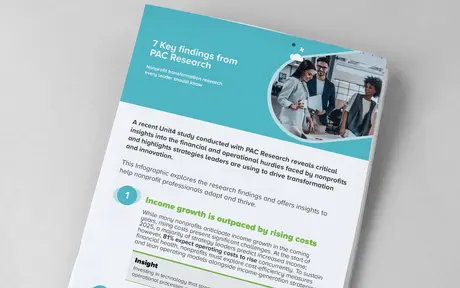From Transition to Transformation: Navigating the future of nonprofits
In a recent webinar hosted by Unit4, Chris Brewer, Global Lead for Nonprofit, and Nick Mayes, Principal Analyst at PAC, explored the accelerating transformation within the nonprofit sector.
The conversation, framed around PAC’s latest research with 200 nonprofit strategy leaders across North America and Europe, tackled key themes: the 2025 nonprofit landscape, operational challenges, shared services, legacy system debt, and the shift to data-centricity.
Amid heightened demand, economic uncertainty, and rising costs, nonprofits are under pressure to deliver more with less while maintaining mission fidelity.
Read more about Nonprofit
This blog distills insights from that discussion to help nonprofits embrace transformation and build sustainable, resilient operating models.
Keep reading:
The nonprofit sector in 2025
Nonprofits face a perfect storm of disruption: financial, geopolitical, and operational. According to PAC’s data:
- 77% expect higher fundraising costs, while 81% anticipate rising operational expenses.
- 79% foresee increased demand for services, yet 32% plan to reduce offerings.
- Only 21% have real-time access to decision-making data.
This dissonance highlights the urgent need for smarter, leaner operating models grounded in digital capability.
Operational challenges
Managing costs is now a strategic imperative. Nonprofits are contending with inflationary pressures on utilities, wages, and logistics costs that, for many, are growing at over 5% annually.
Organizations like CARE International are addressing this through proactive financial stewardship and operational efficiency, balancing program funding with disciplined back-office management. Centralizing functions like finance and HR has unlocked measurable cost savings and enhanced decision agility.
Shared services in the spotlight
One of the most powerful enablers of nonprofit transformation is the adoption of shared services, a model long proven in the private sector, now gaining traction among mission-driven organizations.
UNICEF’s Global Shared Services Center in Budapest, serving over 190 offices, is a prime example. The consolidation has streamlined core functions, reduced transaction times by 27,000 hours annually, and enabled smarter allocation of resources.
Contrary to the misconception, shared services aren’t just for global giants. Advances in SaaS platforms are making it easier for mid-sized nonprofits to adopt scalable, low-overhead shared service models that boost operational resilience.
Is legacy debt a hidden obstacle to innovation?
Outdated legacy systems are one of the most persistent barriers to innovation. Over 45% of nonprofit leaders cite them as a constraint on agility, data access, and scalability.
The Norwegian Refugee Council addressed this by modernizing under a shared digital infrastructure. This pivot enabled real-time responsiveness and logistics coordination, delivering aid to remote regions within 24 hours.
As PAC notes, transformation is a strategic shift away from digital debt toward a future-proof, Cloud-first architecture.
45%
of nonprofit leaders
cite them as a constraint on agility, data access, and scalability.
Becoming data-centric
Data is rapidly emerging as the nonprofit sector’s most underutilized asset. Fragmented systems and siloed processes prevent organizations from unlocking insights needed to scale and adapt.
The British Heart Foundation tackled this with a comprehensive data governance initiative, unlocking real-time operational and financial data to improve decision-making, enhance stakeholder trust, and accelerate impact.
Establishing a data-centric culture is now the foundation for AI adoption, fraud mitigation, and continuous optimization.

More mission, less admin? See how!
Get quick insights with bite-sized demos focused on the challenges and goals of Nonprofit teams.
Fraud risk is a rising threat
PAC research reveals that 70% of nonprofits report stable or increasing incidents of fraud. This is not only a financial risk but a threat to organizational credibility and donor confidence.
The deployment of AI and automation is proving essential. With centralized, clean data, nonprofits can identify anomalies in real time, improving both risk posture and compliance efficiency.
Technology as a strategic differentiator
True digital transformation demands alignment between technology investments and mission outcomes. Based on insights from the webinar, three tech imperatives stand out:
- Prioritize core functions
Nonprofits are modernizing finance, HR, and compliance systems to drive operational clarity and reduce manual overhead. These platforms act as the backbone for broader transformation. - Invest in AI and analytics
Predictive capabilities and intelligent automation can only deliver value once data is structured, centralized, and trustworthy. AI has now gone from experimental to mission-critical. - Adopt Cloud-first strategies
Cloud platforms provide the flexibility, scalability, and low-maintenance infrastructure nonprofits need to innovate rapidly, while reducing the burden of “legacy drag.”
Real-world innovation in action
-
Norwegian Refugee Council: Unified systems under a shared service model to deliver humanitarian support faster than ever before.
-
British Heart Foundation: Built a data-driven culture that accelerates impact and enhances stakeholder engagement.
-
CARE International: Balanced cost optimization with revenue growth to unlock greater programmatic investment.
These organizations prove that transformation is achievable with the right strategy and tools.
How Unit4 supports nonprofit transformation
At Unit4, we understand the unique challenges nonprofit organizations face. Our People Experience Suite is purpose-built to help nonprofits modernize core functions, optimize financial health, and adopt shared services at scale.
Whether you're centralizing operations, transitioning to a Cloud-first model, or building a data-centric organization, our ERPx platform provides the flexibility and intelligence needed to future-proof your mission.
Unit4 enables you to:
-
Eliminate legacy debt with Cloud-native, modular solutions
-
Break down silos through unified finance, HR, and planning systems
-
Improve decision-making with real-time, role-based insights
-
Enhance transparency and compliance to build trust with donors and stakeholders
Let’s redefine what’s possible for nonprofits—together.
The nonprofit sector in 2025
Nonprofits face a perfect storm of disruption: financial, geopolitical, and operational. According to PAC’s data:
- 77% expect higher fundraising costs, while 81% anticipate rising operational expenses.
- 79% foresee increased demand for services, yet 32% plan to reduce offerings.
- Only 21% have real-time access to decision-making data.
This dissonance highlights the urgent need for smarter, leaner operating models grounded in digital capability.
Ready to accelerate your transformation?
If you're ready to evolve from transition to transformation, you can watch a demo or talk to the Unit4 sales team today. Our experts will help you build a tailored roadmap that drives operational resilience and amplifies your mission in a changing world.
You can also watch the full on-demand webinar here to hear the complete conversation between Chris Brewer and Nick Mayes.









